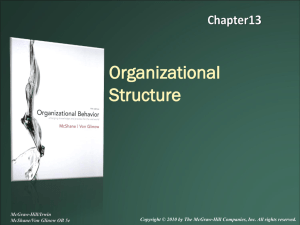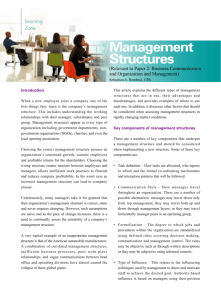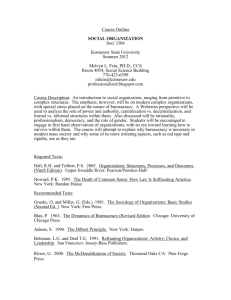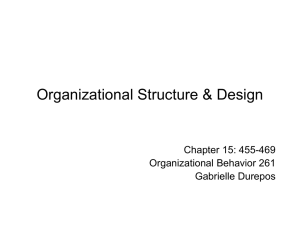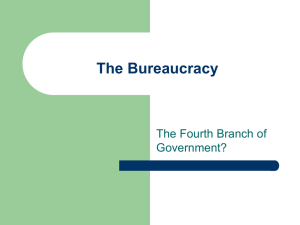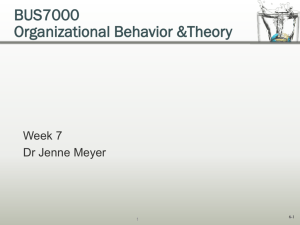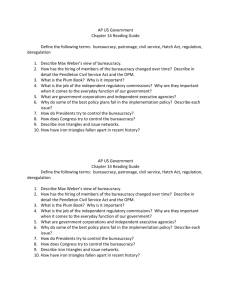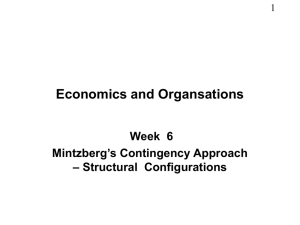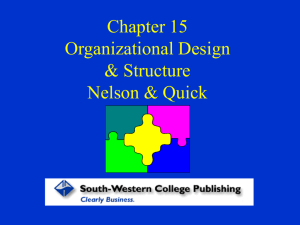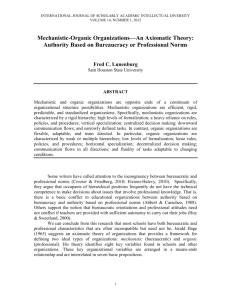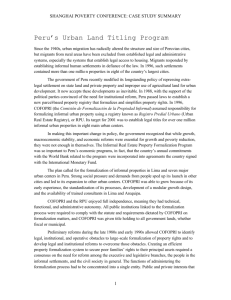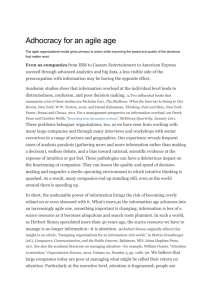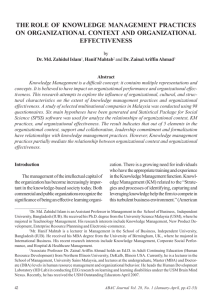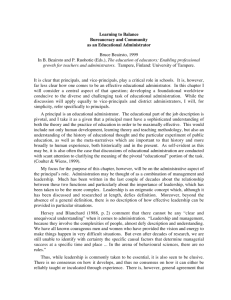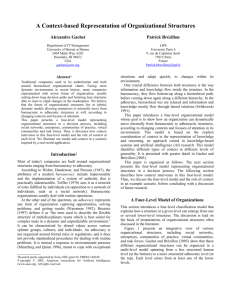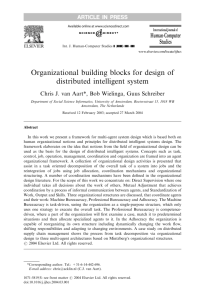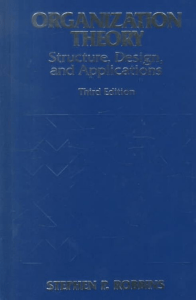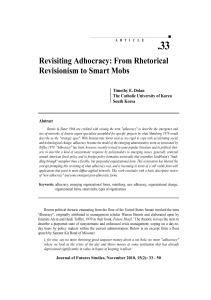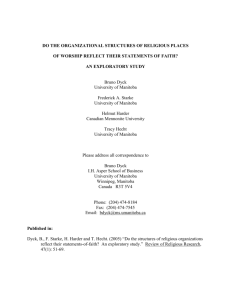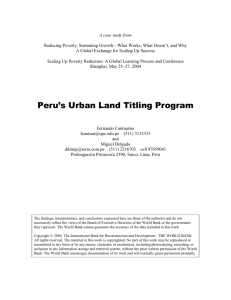Question File
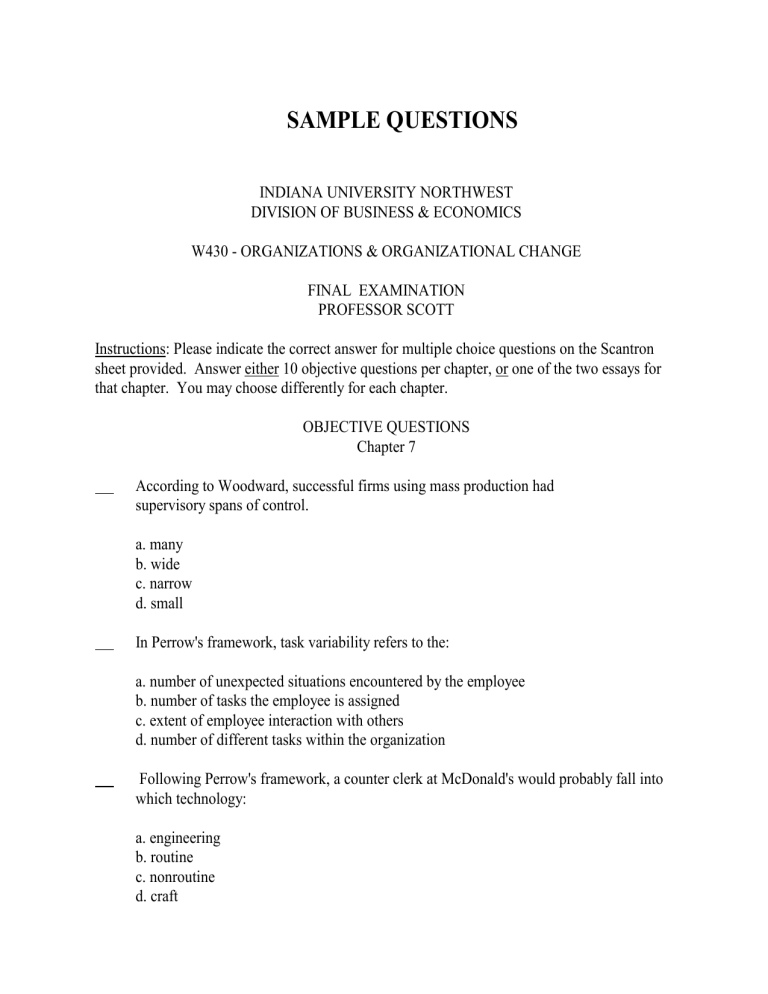
SAMPLE QUESTIONS
INDIANA UNIVERSITY NORTHWEST
DIVISION OF BUSINESS & ECONOMICS
W430 - ORGANIZATIONS & ORGANIZATIONAL CHANGE
FINAL EXAMINATION
PROFESSOR SCOTT
Instructions: Please indicate the correct answer for multiple choice questions on the Scantron sheet provided. Answer either 10 objective questions per chapter, or one of the two essays for that chapter. You may choose differently for each chapter.
OBJECTIVE QUESTIONS
Chapter 7
According to Woodward, successful firms using mass production had supervisory spans of control. a. many b. wide c. narrow d. small
In Perrow's framework, task variability refers to the: a. number of unexpected situations encountered by the employee b. number of tasks the employee is assigned c. extent of employee interaction with others d. number of different tasks within the organization
Following Perrow's framework, a counter clerk at McDonald's would probably fall into which technology: a. engineering b. routine c. nonroutine d. craft
Thompson argued that mediating technology relies on technology. a. crossed b. sequential c. pooled d. reciprocal
Chapter 8
The contribution of Burns' and Stalker's mechanistic-organic typology to the study of technology and its relationship to organization structure is: a. identification of four different kinds of environments b. there are multiple specific environments called subenvironments c. the structure should adjust to the requirements of the environment d. technologies are classified as unit, mass, and process
`Which is the best synonym for "differentiation" as defined by Lawrence and Lorsch? a. differences in the external environment b. different levels of integration c. difference in organizational size d. task segmentation
Dynamic environments are most directly associated with: a. nonroutine technologies b. large size c. organic structures d. standardization
An organic structure fits best when the organization: a. performs routine activities b. is bureaucratic c. is large in size d. faces a rapidly changing environment
Chapter 9
The contingency variables explain approximately percent of the variability in structure. a. 60 b. 75 c. 90 d. 100
Strategic-choice supports: a. optimizing organizational effectiveness b. managerial discretion c. the technology imperative d. the environmental imperative
Which one of the following structural components would enhance the control of those in power? a. high formalization; high centralization b. high complexity; low centralization c. high centralization; low formalization d. high complexity; high formalization
The power-control viewpoint is least relevant when: a. the environment is dynamic b. technology is routine c. organizational slack is minimal d. the environment is abundant
Chapter 10
If control lies in the operating core, which type of structure is most likely to evolve? a. simple b. machine bureaucracy c. professional bureaucracy d. adhocracy
If efficiency is the only concern, and the tasks the organization does are routine, which structure is best? a. simple b. machine bureaucracy c. professional bureaucracy d. divisional
Teams are most synonymous with which structure: a. sector b. divisional c. adhocracy d. professional bureaucracy
Which structure is most likely to stimulate innovation? a. divisional b. adhocracy c. sector d. professional bureaucracy
Chapter 13
The aerospace firm that hires a former Pentagon official to fill an executive position in marketing is using which strategy? a. coopting b. buffering c. lobbying d. coalescing
A restaurant that requires reservations is practicing: a. smoothing b. contracting c. rationing d. none of the above
The most widely used environmental strategy was described as part of: a. recruitment b. advertising c. coopting d. lobbying
Chapter 17
___ Organization decline refers to: a.
a temporary dip in the organization growth curve b.
leaving a nonprofitable market c.
a prolonged decrease in number of personnel d.
showing a loss in profits
___ The growth model suggests that evolution is both followed and preceded by: a.
creativity b.
growth c.
collaboration d.
a crises
___ In a temporary crisis, _______________ tends to increase. a.
complexity b.
formalization c.
centralization d.
the administrative component
___ Which one of the following is not a desirable tactic for dealing initially with decline? a.
increased upward communication b.
work redesign c.
clarify goals d.
participative decision making
Chapter 12 & Information Processing
___ Which one of the following is least descriptive of the network structure? a.
relies on independent contractors b.
interorganizational computer linkage c.
tight control d.
flexibility
___ In the collateral form: a.
an organic structure is placed inside another organic structure b.
a mechanistic structure is placed inside an organic structure c.
a simple structure is merged with a matrix d.
none of the above
___ According to research conducted on information needs: a.
first-line supervisors need information that is detailed b.
middle management needs information from both internal and external sources c.
top-level management needs information that is very wide in scope d.
all of the above
ESSAY QUESTIONS
Chapter 7:
Differentiate between work-unit level and organizational-level analyses of technology. Which is proven to be more valuable in explaining organization structures? Why?
Chapter 9:
"Power is derived from the division of labor that occurs as task specialization is implemented in organizations." Build an argument to support this statement.
Chapter 10:
Review Mintzberg's five configurations from the power-control perspective.
Chapter 12 & Information Processing:
83. Describe and discuss at least four of the various adhocratic types of organizational designs that exist. Explain their purposes and how they are different from one another. Also describe under what conditions each might be appropriate for use in the organization.

